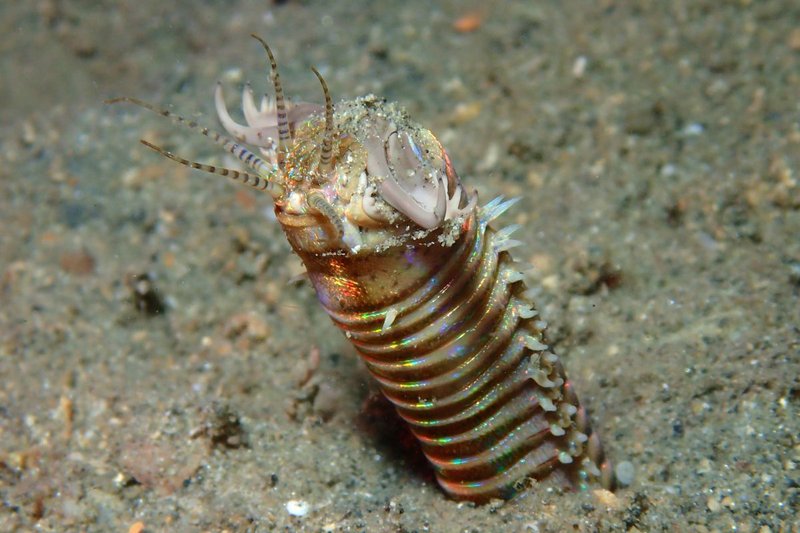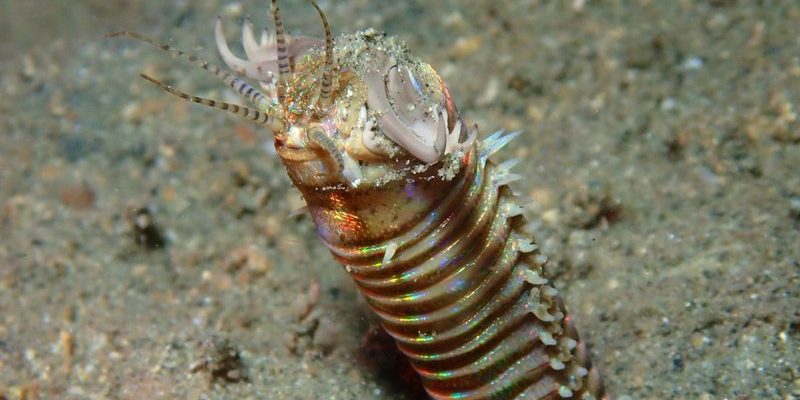
Bobbit worms aren’t your average sea critters. They belong to a group of marine worms known as *Eunice*, and they can grow up to 10 feet long! Yes, you read that right—10 feet. Imagine a worm that can stretch longer than your average living room. You might be wondering where these curious creatures live, how they hunt, and why they matter in the ecosystem. Grab your favorite coffee, and let’s explore all there is to know about bobbit worms.
What Exactly Is a Bobbit Worm?
A bobbit worm is a marine creature that belongs to the annelid class. This means they have a segmented body, which is a signature characteristic of worms. The scientific name for bobbit worms is *Eunice aphroditois*. These worms are typically characterized by their brightly colored bodies, which can feature shades of green, red, or brown. Their long, slender bodies are equipped with powerful jaws that can snatch up prey with lightning speed.
To understand these worms better, think of them as stealthy predators lurking in the ocean floor. They bury themselves in the sand or mud, leaving only their heads visible. When unsuspecting fish come near, the bobbit worm strikes, often with such speed that it can catch its prey off-guard. This unique hunting method makes them effective predators in their underwater environment.
Habitat: Where Do Bobbit Worms Live?
Bobbit worms primarily inhabit warm, tropical and subtropical waters. You can find them in various settings, including coral reefs, sandy bottoms, and muddy environments. They prefer shallow waters but can sometimes be found at depths greater than 300 feet. Their habitat choice doesn’t just influence their hunting; it also plays a significant role in their life cycle.
One of the reasons bobbit worms thrive in specific environments is their role in the ecosystem. They contribute to the health of coral reefs by preying on fish that may otherwise overpopulate certain areas. This balance is essential for maintaining marine biodiversity.
Physical Characteristics of Bobbit Worms
Bobbit worms are unique in both appearance and capabilities. Their bodies can measure anywhere from a few inches to over 10 feet long, with some reports suggesting even longer specimens. They are made up of segments, which allows for mobility. Each segment can have tiny bristles that help them grip the sea floor or move through the sand.
Their most notable feature is their impressive jaws. These jaws are not just for show; they’re capable of delivering a powerful bite. The jaws can be likened to a pair of scissor-like appendages that snap quickly to catch prey. When you see these creatures in action, you might think of a trapdoor spider — patient, camouflaged, and ready to strike when the moment is right.
Feeding Habits of Bobbit Worms
Bobbit worms are carnivorous and have a hunting strategy that’s nothing short of captivating. They wait in their burrows, often camouflaged against the ocean floor. When a fish or other marine creature comes too close, the bobbit worm unleashes its jaws and captures its prey with lightning speed.
What’s fascinating is that these worms don’t just eat anything. They tend to prefer live fish and small crustaceans. Once they catch something, they can consume it whole, using their powerful jaws to tear apart their meal. Think of them as underwater hunters—waiting patiently and striking fast when the opportunity arises.
Reproduction and Life Cycle of Bobbit Worms
When it comes to reproduction, bobbit worms have a rather interesting life cycle. They are known to reproduce through a process called “epitoky.” In simpler terms, parts of the worm’s body become specialized for reproduction, forming a segment filled with gametes. During certain times of the year, these segments detach from the worm and swim away to find mates.
After mating, the fertilized eggs develop into larvae, which eventually settle down and grow into the familiar long, colorful worms we know. This cycle highlights the adaptability of bobbit worms and their ability to thrive in various environments.
Bobbit Worms in Popular Culture
It’s amusing how some creatures find their way into our culture, often in unexpected ways. Bobbit worms have made appearances on social media and television, often depicted as monstrous or terrifying. Their incredible length and fierce hunting tactics can make for some thrilling narratives in documentaries about ocean life.
However, despite their fearsome reputation, bobbit worms are crucial players in the marine ecosystem. Awareness about their role can help shape how we view these unique creatures. They may not be cuddly, but they certainly contribute to the beauty and complexity of ocean life.
Why Should We Care About Bobbit Worms?
Understanding bobbit worms and their role in the ecosystem is important for several reasons. First, they help maintain balance in marine environments by keeping fish populations in check. This balance is crucial for the health of coral reefs and overall marine biodiversity.
Moreover, studying the lives of these creatures can reveal more about ocean health and the impacts of climate change. As our oceans face various threats, every species, big or small, plays a part in the intricate web of life.
So, next time you hear someone mention bobbit worms, you can join in the conversation with a solid understanding of not just what they are but why they matter.
In summary, bobbit worms are remarkable, often misunderstood creatures that deserve attention and appreciation for their unique roles in our oceans. They may look scary, but they’re fascinating links in the chain of life beneath the sea.

